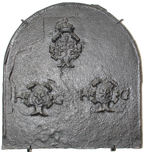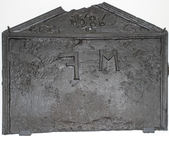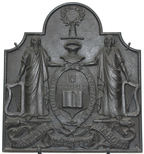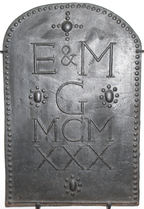-
766
Description: Canted rectangle; ovolo-moulded edging; shield and dolphin crown of the dauphin of France, encircled by the Ordre d'Esprit and the Ordre de St Michel; dolphins in the bottom corners, separating digits of the date.
Notes: The 24th Dauphin was Louis, son of Louis XV and father of Louis XVI. Part of the bequest to the Victoria and Albert Museum by Lieut. Colonel G. B. Croft-Lyons in 1926.
Inscription: 1 7 5 0
Arms: Dauphin of France (24th Dauphin)
- Decoration tags:
- rectangular with canted top corners (shape)
- ovolo (edging)
- whole carved pattern
- armorial
- royal
Manufactured: in 1750 in France.
Current location: Victoria & Albert Museum, Cromwell Road, Kensington & Chelsea, Greater London, England.
Museum number: M.625-1926 (part of the Victoria & Albert Museum museum group)
- Attached to series:
- Foreign armorial firebacks
-
767
Description: Arch shaped; rope edging (top and sides); top centre, slightly over-pressed crowned cartouche with initials F S linked with twisted cord; below, two cartouches, each bearing a 7-pointed star, and each separating the paired initials HG.
Notes: The national origin of this fireback is a little uncertain. A variant of this fireback (no. 1306) has slightly different proportions and relative positions of the stamps.
Inscription: F S / H G H G
- Decoration tags:
- rounded arched (shape)
- rope (edging)
- carved stamps
- heraldic
- text
Manufactured: in the 16th century possibly in the Lorraine area of France.
Current location: Victoria & Albert Museum, Cromwell Road, Kensington & Chelsea, Greater London, England.
Museum number: 888.1901 (part of the Victoria & Albert Museum museum group)
- Attached to series:
- Miscellaneous stamp firebacks
- Cord-linked initials firebacks
-
768
Description: Arched rectangular shape with rounded corners; ovolo within fillet moulding all round; oval Tudor royal shield with garter surrounding, topped with a royal crown; dragon and greyhound supporters; initials split by crown; inscription on a fillet between legs of supporters, behind garter finial; motto on an Ionic plinth at bottom; two rectangular side panels with twisted rope edging top and side; a short length of turned dowel stamped four times, diagonally, on each panel.
Notes: The supporters are those of Henry VII or Henry VIII, but the initials suggest the fireback dates from the reign of Edward VI (1547-53). John Harvo (d. c1565) was a gunfounder who has been identified as occupying Pounsley furnace, Framfield, Sussex, possibly from as early as 1547; the fireback may have been cast originally during the reign of Henry VIII (1509-47), with the initials added to an early casting using the original pattern. The disparity between the worn surface of the armorial panel and the greater clarity of the extensions indicates that the extended casting was made using an already well-used armorial fireback and therefore at a substantially later date.
Copies of this fireback are known.
Inscription: E R / HONY SOIT QVE MAL Y PAYNCE / Made in Sussex by John Harvo / DV ET MOVN DROI
Arms: Tudor royal - Probably Henry VIII
- Decoration tags:
- rectangular with round arch (shape)
- rope (edging)
- carved stamps
- whole carved pattern
- individual letters
- extension panels
- armorial
- royal
- text
- objects
Manufactured: in the late-16th century in England.
Current location: Victoria & Albert Museum, Cromwell Road, Kensington & Chelsea, Greater London, England.
Museum number: 685.1899 (part of the Victoria & Albert Museum museum group)
- Attached to series:
- Pounsley series
- John Harvo series
-
769
Description: Rectangular; cavetto-moulded edge; a snake rises from a fire and bites the middle finger of the hand of a sleeved left arm that descends from a top right corner cloud; left and right, ‘S’ scrolls appear strapped to the edge of the fireback; the date, top left of centre; initials, bottom right corner.
Notes: An illustration of the New Testament episode (Acts 28: 3) when St Paul, shipwrecked in the island of Malta, was putting sticks on a fire and a viper bit him. The distinctive shape of the ‘1’ in the date and the initials, ‘IM’, together with the ‘S’ scrolls, parallel such features in other firebacks. The design is an adaptation of an illustration in 'Devises Heroiques' by Claudius Paradin (1557) which was translated into English by Geoffrey Whitney as 'The Book of Emblemes' (1586).
Copies of this fireback are known.
Inscription: 1649 / IM
- Decoration tags:
- rectangular (shape)
- cavetto (edging)
- whole carved pattern
- biblical
- text
- animals
- humans
Manufactured: in 1649 possibly at Brede Furnace in the Weald area of England.
Current location: Victoria & Albert Museum, Cromwell Road, Kensington & Chelsea, Greater London, England.
Museum number: M.119-1984 (part of the Victoria & Albert Museum museum group)
Citation: Hamling, T., 2010, Decorating the 'Godly' Household (New Haven, Yale), pp. 251-2.
- Attached to series:
- IM series
- Hooked '1' series
- New Testament firebacks
- Brede group
-
771
Description: Rectangular with triangular pediment; stepped fillet and ogee moulded edge; initials in rectangular panel (F reversed); date in pediment.
Notes: The triangular top is a separate element, in this instance impressed before the lower panel. A variant at Hastings Museum (no. 118) has the letters positioned slightly differently.
Inscription: 1586 / FM
- Decoration tags:
- triangular arched (shape)
- stepped fillet and ogee (edging)
- individual letters
- date stamp
- text
Manufactured: in 1586 in the Weald area of England.
Current location: Victoria & Albert Museum, Cromwell Road, Kensington & Chelsea, Greater London, England.
Museum number: M.129-1913 (part of the Victoria & Albert Museum museum group)
- Attached to series:
- 1586 series
- Date & initials firebacks
-
772
Description: Cavetto canted arched rectangle; astragal edging; oval inscription surrounding a central battlemented shield bearing an open book, with a baronet's escutcheon above; above, a helm with a crest of an arm and hand holding a wreath; on each side, a druid supporter holding a harp, each upon a horizontal fillet; below, intertwined bell flowers behind a tripartite motto scroll.
Notes: The motto appears to have been incorrectly spelled; the Conroy baronetcy was created for Sir John Conroy, comptroller of the household of the Duchess of Kent, and much hated by her daughter, Princess (later Queen) Victoria; the 3rd (and last) baronet succeeded to the title in 1869.
Inscription: FIDELITER ET CONSTANTER [Faithfully and constantly] / L'ANTIQIVITE NE PEVX PAS L'ABOLIR [Antiquity cannot abolish it]
Arms: Conroy, baronet, of Llanbrynmair (Sir John Conroy, 3rd baronet, 1845-1900)
- Decoration tags:
- rectangular with canted top corners and round arch (shape)
- astragal (edging)
- whole carved pattern
- armorial
- text
- humans
Manufactured: in the late-19th century in England.
Current location: Victoria & Albert Museum, Cromwell Road, Kensington & Chelsea, Greater London, England.
Museum number: 502.1896 (part of the Victoria & Albert Museum museum group)
- Attached to series:
- Personal armorial firebacks
- Welsh armorial firebacks
-
774
Description: Arched shape with bead edging; from top, large bead with four pairs of small beads in a cross shape, text with pellet surrounded by eight beads on each side of 'G', and at bottom.
Notes: Made by, and bearing the initials of Eric Gill and his wife, Mary, in 1930.
Inscription: E&M / G / MCM / XXX
- Decoration tags:
- rounded arched (shape)
- bead (edging)
- whole carved pattern
- text
Manufactured: in 1930 at Loosley Row Foundry possibly in the Chilterns area of England.
Current location: Victoria & Albert Museum, Cromwell Road, Kensington & Chelsea, Greater London, England.
Museum number: M.4-1983 (part of the Victoria & Albert Museum museum group)
- Attached to series:
- Personal firebacks
- Date & initials firebacks
-
775
Description: Arched rectangle; ovol-moulded edging; pictorial scene of a begowned figure waving to figures standing beneath a portico with a sun behind, other figures opening a door to his left, above which is the shape of the man in the moon; blottom left, a computer; bottom right, a painter's palette.
Notes: A farewell gift to William Vaughan, Reader in Art History at University College, London (later professor of the History of Art at Birkbeck College).
Inscription: WILLIAM VAUGHAN / 1972 UNIVERSITY 1986 / COLLEGE
- Decoration tags:
- rectangular with round arch (shape)
- ovolo (edging)
- whole carved pattern
- pictorial
- architectural
- text
- humans
Manufactured: in 1987 in England.
Current location: Victoria & Albert Museum, Cromwell Road, Kensington & Chelsea, Greater London, England.
Museum number: M.15-1994 (part of the Victoria & Albert Museum museum group)
- Attached to series:
- Personal firebacks
-
776
Description: Stove-plate; poss. fragment; rectangular; flanged edging on top and sides; pictorial scene illustrating the biblical tale of Joshua and the five kings.
Notes: Joshua 10.
- Decoration tags:
- rectangular (shape)
- flanged (edging)
- whole carved pattern
- pictorial
- biblical
- humans
Manufactured: in the mid- to late-16th century possibly in the Eifel area of Germany.
Current location: Victoria & Albert Museum, Cromwell Road, Kensington & Chelsea, Greater London, England.
Museum number: 289.1923 (part of the Victoria & Albert Museum museum group)
- Attached to series:
- Stoveplates
-
777
Description: Rectangular; cavetto-moulding within a flanged edge; floriate arch above a female figure with a child in her left arm and another by her right side, initials split by the group; below a simulated rope-twist fillet, elaborate floriate cartouche containing the word, CHARITAS.
Notes: A late stove-plate, illustrated in von den Driesch p.484.
Copies of this fireback are known.
Inscription: G S / CHARITAS
- Decoration tags:
- rectangular (shape)
- flanged (edging)
- whole carved pattern
- pictorial
- allegorical
- text
- humans
Manufactured: in the late-17th century in the Siegerland area of Germany.
Current location: Victoria & Albert Museum, Cromwell Road, Kensington & Chelsea, Greater London, England.
Museum number: 890.1901 (part of the Victoria & Albert Museum museum group)
- Attached to series:
- Stoveplates









